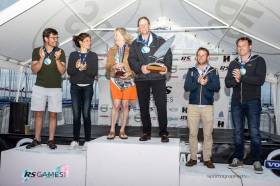Displaying items by tag: RS400 Europeans
Cork Harbour’s Barry & Leonard Third In RS400 Europeans
#RS400 - Alex Barry and Richard Leonard finished third in the RS400 Europeans at Weymouth this week.
The Cork Harbour duo completed an international podium, with Stewart and Sarah Robertson of Scotland taking the win and Francisco and Teresa Lobato of Portugal in second.
Sailing was very tight throughout the five days of racing for the 71-boat fleet, with Barry reporting that any one of five boats was capable of taking the event in the last race.
Notable entries included double Olympic silver medalist and Volvo Ocean Race winner Ian Walker, who was ninth overall.
Robbie O’Sullivan and Phil McGlade were the other Irish boat traveling, with a 33rd place finish in the Gold fleet. Full results are here.
The event was part of the wider RS anniversary games, which will see 2,000 sailors take to the water at the Weymouth and Portland National Sailing Academy by the end of this month.





























































